|
CONTENTS
Lineup Card and "Clean Up Man"
AL Pinch-Hit Grand Slam
Dishonest Ump
Polo Grounds Game
Yankee Stadium Game
Televised Game
Major League Telecast
Diamond Vision
Teammates Ejected for Fighting
North Side Park
Baseball Firsts – I
Baseball Firsts – II
Baseball Firsts – IV
Baseball Firsts – V
Baseball Firsts – VI
Baseball Firsts – VII
Baseball Magazine
Golden Rankings Home
Top of Page
|
Baseball
Firsts Archive - III
Lineup Card and "Clean Up Man"
The lineup card began in 1881 when the National League adopted a rule requiring "the captain of each nine to furnish the entire batting order by nine o'clock on the morning of each game." Previously, captains often changed the order in the middle of the game. It wasn't until 1908 that the fourth-place hitter in the lineup was first called "the cleaner-up" and eventually the "clean-up man."
|
Marty Kavanagh of Cleveland was credited with the American League's first pinch-hit grandslam when the ball he hit rolled through an opening in the fence and could not be recovered in time. It happened on September 24, 1916 (in the AL's 15th year of existence), as the Indians beat the Red Sox, 5-3. Under today's rules, the hit would be a ground rule double.
Reference: Rich Marazzi, The Rules and Lore of Baseball
|
First (and only) umpire judged guilty of dishonesty on the field: 1882 Richard Higham, former manager and NL player, was banished from the league for advising gamblers how to bet on games he umpired. Actually, there had been rumors that he was throwing games as a player. Yet he was hired as an umpire. In Higham's second year in that role, William G. Thompson, owner of the Detroit Wolverines, got suspicious about some of the calls Higham made against his team. He hired a private detective, who turned up several letters between Higham and a well-known gambler. Higham outlined a simple code – if the gambler received a telegram from him saying "Buy all the lumber you can," the gambler was to bet on Detroit. No telegram meant that the gambler was to bet on the opponent.
|
The first baseball game played in New York in a place called "the polo grounds" took place in September 1880. That year, John B. Day, a young cigar wholesaler, founded an independent team called the Metropolitans. Initially, the team played its games in Brooklyn and Hoboken NJ, as the other clubs did. However, Day found a better place to play than Brooklyn, which was not yet connected by bridge to Manhattan. Immediately north of Central Park, from 110th to 112th Street west of Fifth Avenue, was an area where polo was played. This site became the first professional baseball field in Manhattan.

Polo Grounds 1887
Eventually, the name "Polo Grounds" was applied to three additional fields/stadiums, the most famous being the home of the New York Giants from 1891-1957 and the expansion New York Mets for two seasons before Shea Stadium opened in 1964.
|

Yankee Stadium on Opening Day 1923

President Warren Harding and Babe Ruth
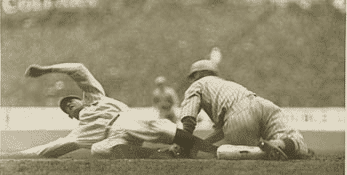
Yankee 2B Aaron Ward out at 3B
|
The first game in Yankee Stadium was played on April 18, 1923. By far the largest baseball crowd to that point, 74,217, gathered on a chilly (49º) day for the 3:30 game, and 25,000 more were denied admission, many of them loitering outside the stadium during the game. (One source says the attendance was "later changed to 60,000.")
John Philip Sousa and his Seventh Regiment Band led the teams and the two owners, the infamous Harry Frazee of the Boston Red Sox and Jake Ruppert of the Yankees, to the CF flag pole for the opening ceremonies. Babe Ruth had declared, "I'd give a year of my life if I can hit a HR in this first game in this new park."
New York won 4-1 as Babe did indeed hit the first round tripper, a three-run liner off Howard Ehmke into the RF bleachers in the bottom of the third. The New York Times called it "a savage HR that was the real baptism of Yankee Stadium." Rounding the bases, Babe beamed from ear to ear and waved his cap to the frenzied fans.
With two out in the ninth, the game was held up as the crowd swarmed onto the field around Ruth and other players. Umpire Tom Connally finally let the game proceed. George Burns fanned for the final out.
The Stadium had been completed at a cost of $2.5 million, a mammoth amount at that time. By comparison, the extensive renovation of Yankee Stadium after the 1973 season cost $48 million, and the new Yankee Stadium is estimated at $1.3 billion.
Reference: "The First Game at Yankee Stadium," Arthur O. Schott, Baseball Research Journal, 1973
|
|
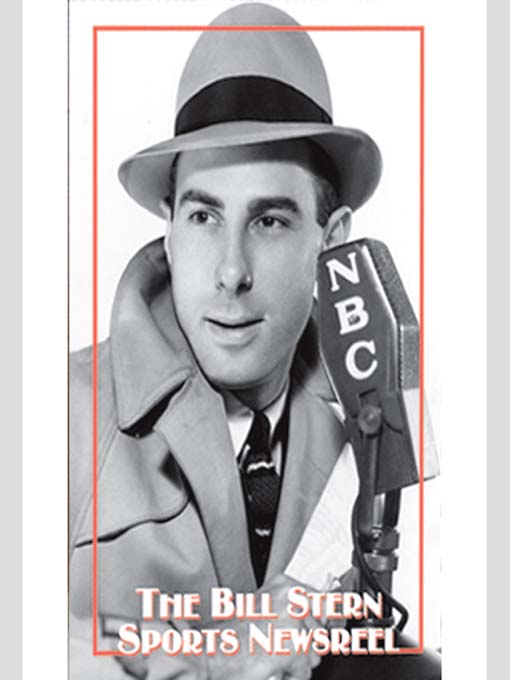 |
The first baseball televised baseball game took place on May 17, 1939. It was a college contest between Princeton and Columbia at Baker Field in upper Manhattan NY. NBC broadcast the game using only one camera on its experimental station W2XBS based in the Empire State Building. The range of the broadcast was approximately 50 miles to a potential audience of about 100 TV sets. The announcer was Bill Stern, who was more famous for calling football games on radio.

|
|
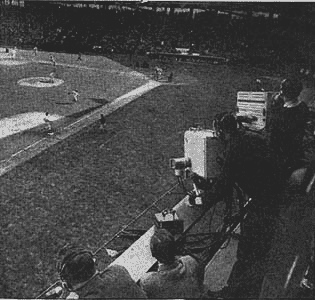
|
The first telecast of a major league game took place on Saturday, August 26, 1939. It was the first game of a doubleheader at Ebbets Field, Brooklyn, between the Dodgers and Cincinnati. 35,535 fans saw the league-leading Reds win, 5-2.
NBC broadcast the game on its experimental station W2XBS based in the Empire State Building in Manhattan. The broadcast range was approximately 50 miles to a potential audience of about 100 TV sets. Two cameras were used. One was in the upper deck behind 3B, where Brooklyn's radio announcer, Red Barber, called the game. The other camera was behind home plate. Barber wore earphones that connected him to the director, Burke Crotty, stationed in a bus outside the stadium. With no monitor to look at, Red relied on Crotty to tell him what the TV audience was seeing.
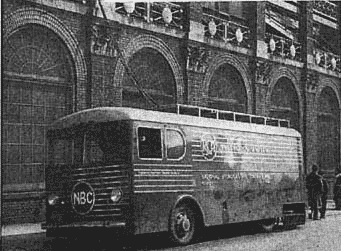
|
|
In 1980, Mitsubishi installed its Diamond Vision technology at Dodger Stadium. The super scoreboard made its debut at the All-Star Game. It was the largest full-color matrix board in the world: 35' x 25'. Engineered using the same principle as color TV sets, the screen consisted of 38,400 red, green, and blue lights. The Dodgers have updated their video display system in 1991 and 2003.
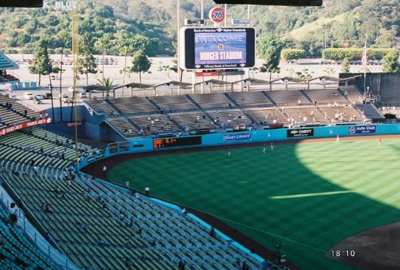
|
|
Teammates Ejected for Fighting

|
On September 11, 1906, during a game at Hilltop Park against the New York Highlanders, Hobe Ferris of the Boston Red Sox, "notorious for his hard style of play" and hot temper, berated teammate Jack Hayden for lackadaisical play. Fisticuffs ensued and, after teammates separated the combatants, Ferris braced himself against the dugout rail and kicked Hayden in the face, knocking out several teeth. The fight resumed until broken up again. Both were ejected from the game, making this the first time that teammates had been ejected for fighting each other. Ferris was also suspended for the rest of the season.One reporter called the fight "the most disgraceful affair every predicated of any players on the ball field."
Ferris is also credited (or discredited) with another first. He committed the first error in World Series history in the top of the first of the opening game of the 1903 World Series. Playing 2B, Hobe fumbled a ball off the bat of Pittsburgh's Kitty Bransfield. Ferris made amends by driving in all of Boston's runs in the 3-0 victory in the 8th and final game of the best-of-five series.
|
|
What is known today as Wrigley Field was built in 1914 by "Lucky Charlie" Weeghman for his Federal League team. It was the first ball park on the north side of Chicago. In fact, on opening day Chicago Tribune columnist Ring Lardner wrote: "Many of our citizens will today visit the North Side for the first time" to see the Federals play.
To sell his team in a city that already had two major league clubs, Charlie instituted some innovations.
- He became the first owner to let fans keep balls hit into the stands.
- When patrons complained that vendors blocked their view, Weeghman installed the first permanent concession stands.
- Although the AL and NL outlawed it, he reinstated Ladies Day.
Another example of his willingness to change to fit conditions came after the first series in the new arena. When nine HRs were hit in three games, he decided that 310' to the LF wall down the line was too close. So, on an off day, he had workmen remove the front porch of an adjacent house and move the fence back 25'.
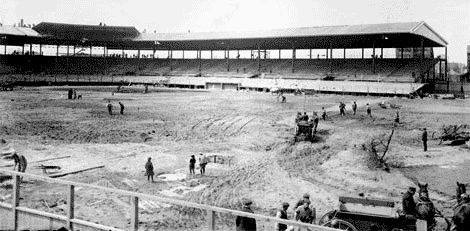
Construction of Weeghman Park 1914
|
|
|